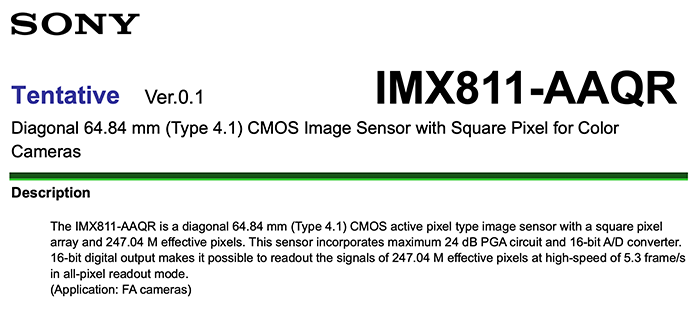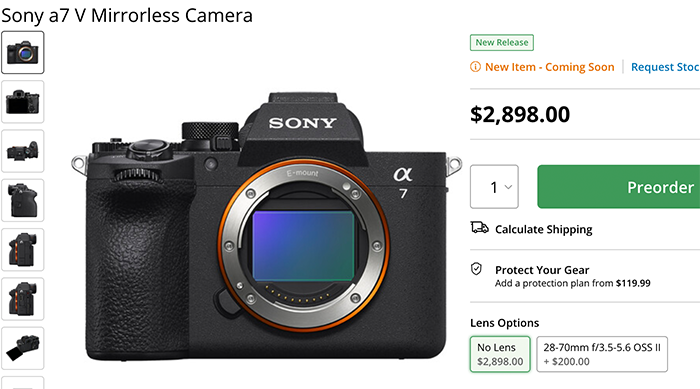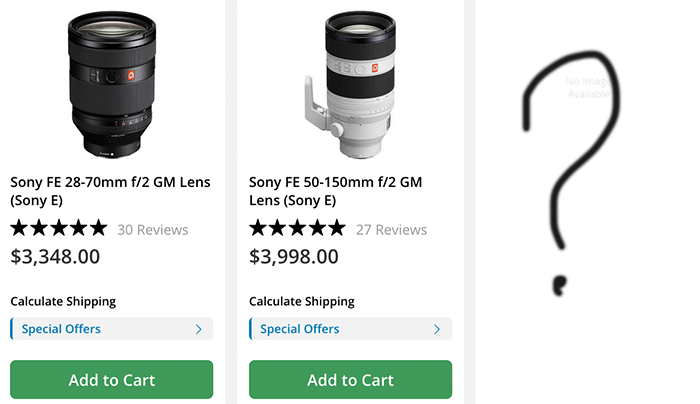First Black Friday deal: get 77% off Luminar Neo.
You now save up to 77% on the Luminar Neo software (Click here). Add our checkout code “SAR” to get additional 10 Dollar/Euro discount!
Limited time deal: Save 15% sitewide at SmallRig!
For the next 48 hours, you can save 15% on all products at the SmallRig Store (Click here) by using the checkout code “ATC15.”
First hints about another Sony announcement in late January!
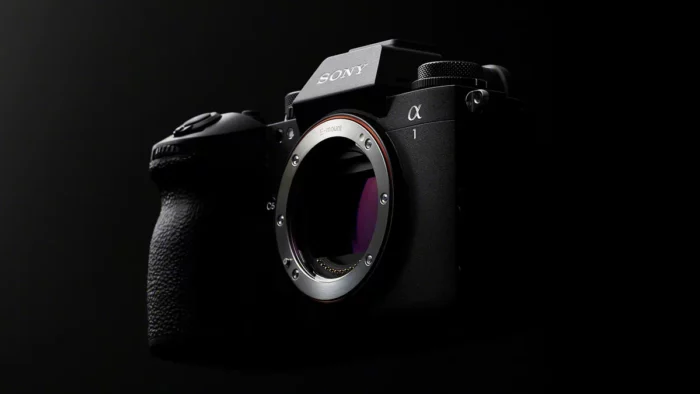
It looks like Sony will have two announcements withing the next 3 months:
- One product announcement in mid November (or max early December)
- One product announcement in late January.
I still have no 100% confirmation about what product will be announced when. All I know for sure is that the Sony A7V is going to start shipping out in Q1 2026. And here are the four products that will be announced within the next few months:
- Sony A7V
- 100-400mm f/4.0 GM
- 100-400mm G (variable aperture)
- f/2.0 GM ultra wide angle zoom
Let’s see…
Viltrox is preparing to release new 0.8x and 1.4x front lens converters!
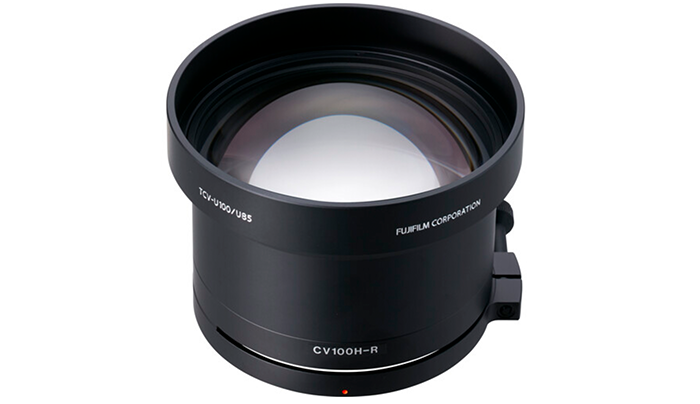
Image on top shows the Fujinon 1.5x Tele Converter which sells for many thousends of Dollars on BHphoto
On Reddit Viltrox announced this:
We’ll soon be launching a front teleconverter (increasing the focal length by 1.4×) and a wide-angle conversion lens (reducing the focal length to 0.8×). With these, you can instantly unlock new focal lengths without changing your camera. Stay tuned, and thank you for your question!
Here are some examples of conversions you get on Sony lenses:
- Sony FE 12–24mm f/2.8 GM
- 1.4× → 17–34mm
- 0.8× → 10–19mm
- Sony FE PZ 28–135mm f/4 G OSS
- 1.4× → 39–189mm
- 0.8× → 22–108mm
- Sony FE 100–400mm f/4.5–5.6 GM OSS
- 1.4× → 140–560mm
- 0.8× → 80–320mm
- Sony FE 50mm f/1.2 GM
- 1.4× → 70mm
- 0.8× → 40mm
- Sony FE 200–600mm f/5.6–6.3 G OSS
- 1.4× → 280–840mm
- 0.8× → 160–480mm
- Sony FE 16–35mm f/2.8 GM
- 1.4× → 22–49mm
- 0.8× → 13–28mm
- Sony FE 70–200mm f/2.8 GM OSS
- 1.4× → 98–280mm
- 0.8× → 56–160mm
- Sony FE 14mm f/1.8 GM
- 1.4× → 20mm
- 0.8× → 11mm
- Sony E 16–55mm f/2.8 G (APS-C)
- 1.4× → 22–77mm
- 0.8× → 13–44mm
- Sony FE 35mm f/1.4 GM
- 1.4× → 49–50mm
- 0.8× → 28mm
- Sony FE 24mm f/1.4 GM
- 1.4× → 34mm
- 0.8× → 19mm
- Sony FE 24–70mm f/2.8 GM
- 1.4× → 34–98mm
- 0.8× → 19–56mm
- Sony FE 70–300mm f/4.5–5.6 G OSS
- 1.4× → 98–420mm
- 0.8× → 56–240mm
- Sony FE 85mm f/1.4 GM
- 1.4× → 119mm
- 0.8× → 68mm
- Sony FE 50mm f/1.4 GM
- 1.4× → 70mm
- 0.8× → 40mm
- Sony FE 16–25mm f/2.8 G
- 1.4× → 22–35mm
- 0.8× → 13–20mm
- Sony FE 24–240mm f/3.5–6.3 OSS
- 1.4× → 34–336mm
- 0.8× → 19–192mm
- Sony FE PZ 16–35mm f/4 G
- 1.4× → 22–49mm
- 0.8× → 13–28mm
- Sony FE 24–50mm f/2.8 G
- 1.4× → 34–70mm
- 0.8× → 19–40mm
- Sony FE 20–70mm f/4 G
- 1.4× → 28–98mm
- 0.8× → 16–56mm
- Sony E 70–350mm f/4.5–6.3 G OSS (APS-C)
- 1.4× → 98–490mm
- 0.8× → 56–280mm
- Sony FE 24–105mm f/4 G OSS
- 1.4× → 34–147mm
- 0.8× → 19–84mm
- Sony Sonnar T* FE 55mm f/1.8 ZA
- 1.4× → 77mm
- 0.8× → 44mm
- Sony FE 20mm f/1.8 G
- 1.4× → 28mm
- 0.8× → 16mm
🔥 Sony Is About to Announce the World’s Fastest f/2.0 Ultra-Wide Zoom Lens! + 2 more telezooms!
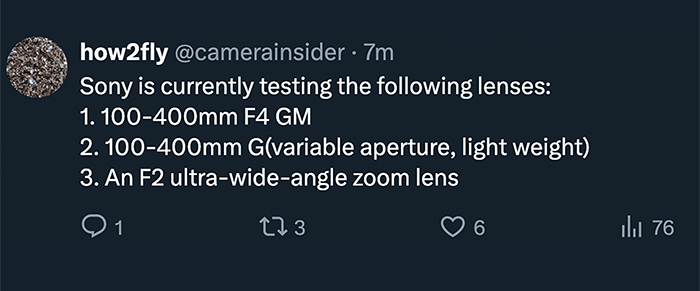
My buddy How2fly shared reliable info about three new exciting Sony lenses that will be announced soon:
- 100-400mm F4 GM (successor of the 7 year old 100-400mm f/4.5-5.6 GM)
- 100-400mm G (variable aperture, light weight)
- An F2 ultra-wide-angle zoom lens companion of the 28-70mm and 50-150mm f/2.0 GM lenses
No exact dates yet, but these lenses are currently planned for release between November and Q1 2026. My reliable sources say the Sony A7V is coming between mid-November and early December — and I wouldn’t be surprised if Sony unveils one or even two of these lenses together with the new camera. Let’s dig into this rumor:
100-400mm double release:
I think it’s great Sony will offer a more affordable and lightweight version of the 100-400 GMII. I guess variable aperture could be f/5.6-6.3. I wonder, is this something that you are likely to buy?
f/2.0 ultra wide zoom:
I’m not sure about the final focal length yet. Because it’s f/2.0, it likely won’t be a standard 16–35mm. I’m expecting something more like 16–25mm or 16–28mm. Which range would you want to see?
–
To share rumors please reach out using my anonymous contact form or contact me via eMail, Signal, Telegram. Thanks!
To not miss any new rumor subscribe our Newsletter:
Social Networks:
- Subscribe my youtube channel: Usually I do post the rumors there 15-30min in advance before I post them on SAR
- Follow me on Twitter: Yep, I paid for the blue check so that you will actually see me.
- Follow my page on Facebook: Be sure to select “Favorites” to be notified when there is a new article online
- Follow me on Instagram: Ok, this one is more tricky as I am currently getting lost having fun with Ai images :)
